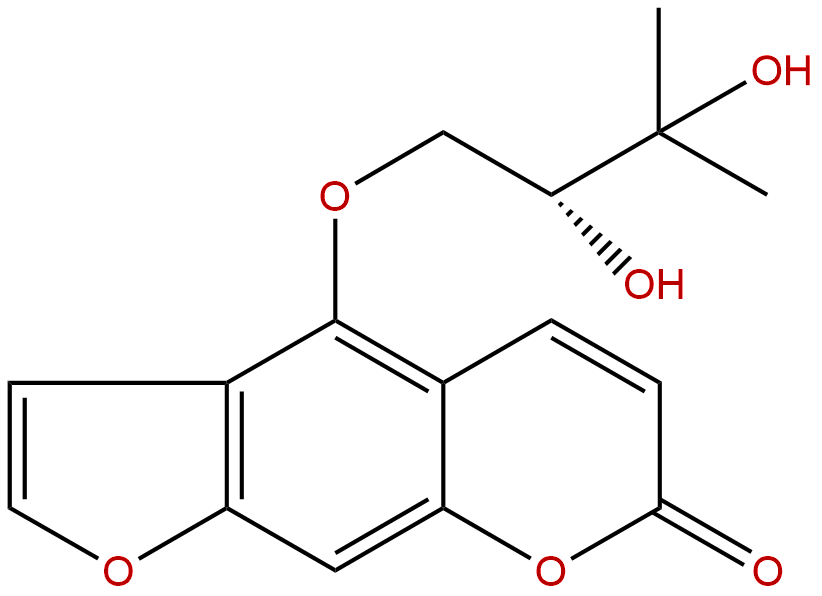
Oxypeucedanin hydrateCAS No.:2643-85-8
|
||||||||||
 |
|
|
||||||||

| Catalogue No.: | BP1051 |
| Formula: | C16H16O6 |
| Mol Weight: | 304.298 |
Synonym name: Aviprin; Hydroxypeucedanin hydrate; Prangol; Prangolarin hydrate
Catalogue No.: BP1051
Cas No.: 2643-85-8
Formula: C16H16O6
Mol Weight: 304.298
Botanical Source:
Purity: 95%~99%
Analysis Method: HPLC-DAD or/and HPLC-ELSD
Identification Method: Mass, NMR
Packing: Brown vial or HDPE plastic bottle
Can be supplied from milligrams to grams.
For Reference Standard and R&D, Not for Human Use Directly.
Inquire for bulk scale.
Description:
Oxypeucedanin hydrate is an antimutagenic agent, it has antioxidant activity, and exhibits carbohydrate metabolizing enzymes inhibitory effect.
References:
J Chromatogr B Biomed Sci Appl. 2001 Apr 5;753(2):309-14.
Simultaneous determination of byak-angelicin and oxypeucedanin hydrate in rat plasma by column-switching high-performance liquid chromatography with ultraviolet detection.
METHODS AND RESULTS:
A simple and sensitive column-switching HPLC method was developed for the simultaneous determination of two furocoumarin compounds, byak-angelicin and Oxypeucedanin hydrate, which are the main components of hot water extract of Angelica dahurica root (AE), in rat plasma. Plasma sample was simply deproteinated with perchloric acid. After centrifugation, the supernatant was injected into a column-switching HPLC system consisting of a clean-up column (Symmetry Shield RP 8, 20x3.9 mm I.D.) and analytical column (Symmetry C18, 75x4.6 mm I.D.) which were connected with a six-port switching valve. The flow-rate of the mobile phase (acetonitrile-water, 20:80) was maintained at 1 ml/min. Detection was carried out at wavelength 260 nm with a UV detector. The column temperature was maintained at 40 degrees C. The calibration curves of byak-angelicin and Oxypeucedanin hydrate were linear over the ranges 19.6 to 980 ng/ml (r2>0.997). The accuracy of these analytes was less than 4.4%. The intra- and inter-day relative standard deviations of byak-angelicin and Oxypeucedanin hydrate were within 12.0% and 12.7%, respectively.
CONCLUSIONS:
The present method was applied for the analysis of plasma concentration from rats after administration of AE.
Biomed Res Int. 2014;2014:480545.
Preliminary in vitro and in vivo evaluation of antidiabetic activity of Ducrosia anethifolia Boiss. and its linear furanocoumarins.
Ducrosia anethifolia is used as flavoring additive. There have been little detailed phytochemical reports on this genus and the antidiabetic activity of this plant is not yet evaluated.
METHODS AND RESULTS:
Structure of compounds was deduced by spectroscopic analyses. Preliminary in vitro evaluation of the antidiabetic activity of crude extract and its furanocoumarins was carried out ( α -amylase, α -glucosidase, and β -galactosidase). The in vivo activity was investigated by measuring some oxidative stress markers. Biomarkers of liver injury and kidney were also determined. Eight linear furanocoumarins, psoralen, 5-methoxypsoralen, 8-methoxypsoralen, imperatorin, isooxypeucedanin, pabulenol, oxypeucedanin methanolate, Oxypeucedanin hydrate, and 3-O-glucopyranosyl- β -sitosterol, were isolated. All compounds were reported for the first time from the genus Ducrosia except pabulenol. The blood glucose level, liver function enzymes, total protein, lipid, and cholesterol levels were significantly normalized by extract treatment. The antioxidant markers, glucolytic, and gluconeogenic enzymes were significantly ameliorated and the elevated level of kidney biomarkers in the diabetic groups was restored. The compounds showed inhibitory activity in a concentration dependant manner. Imperatorin and 5-methoxypsoralen showed the most potent inhibiting power.
CONCLUSIONS:
D. anethifolia extract showed hypoglycemic, hypolipidemic, and antioxidant effect as well as ameliorating kidney function. This extract and some linear furanocoumarins exhibited carbohydrate metabolizing enzymes inhibitory effect.